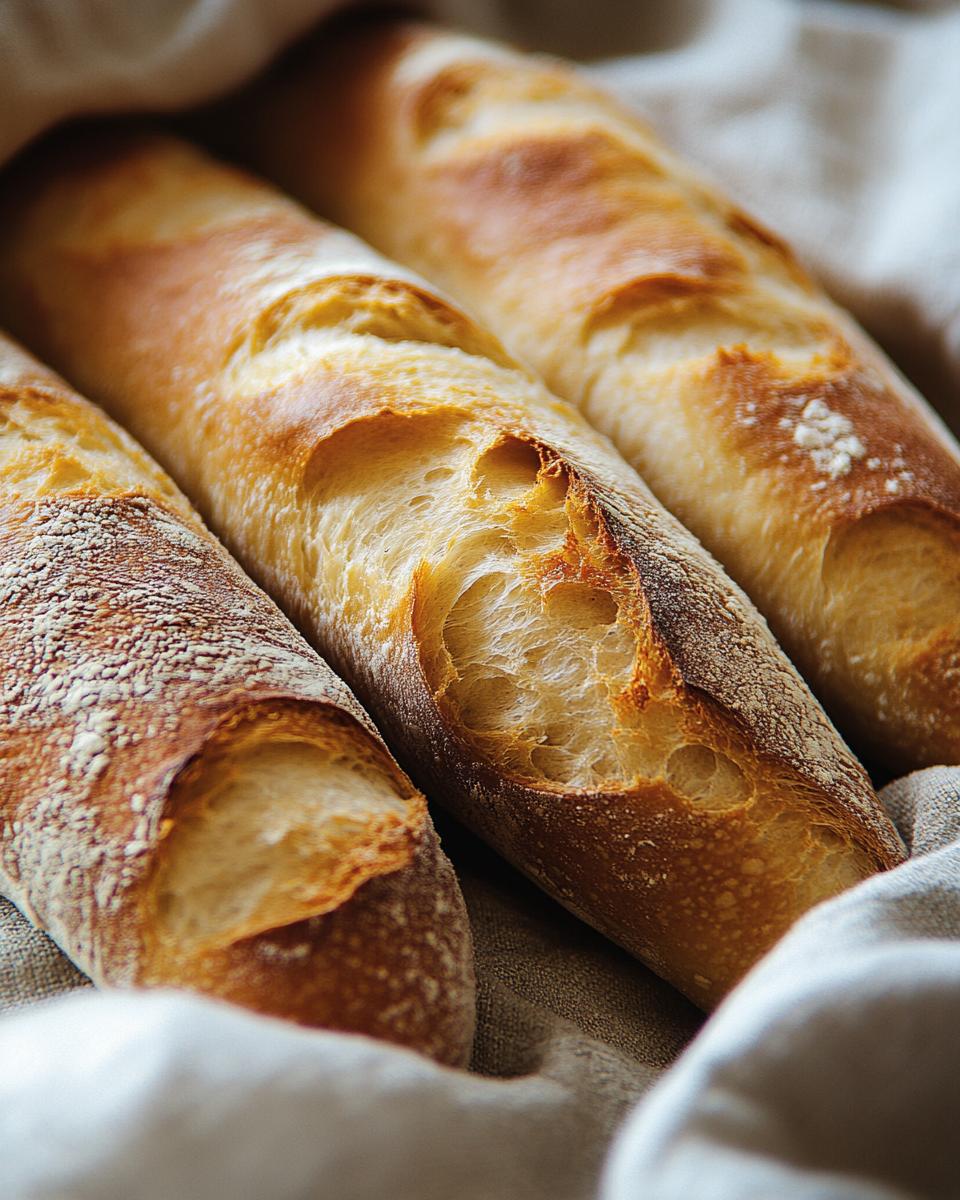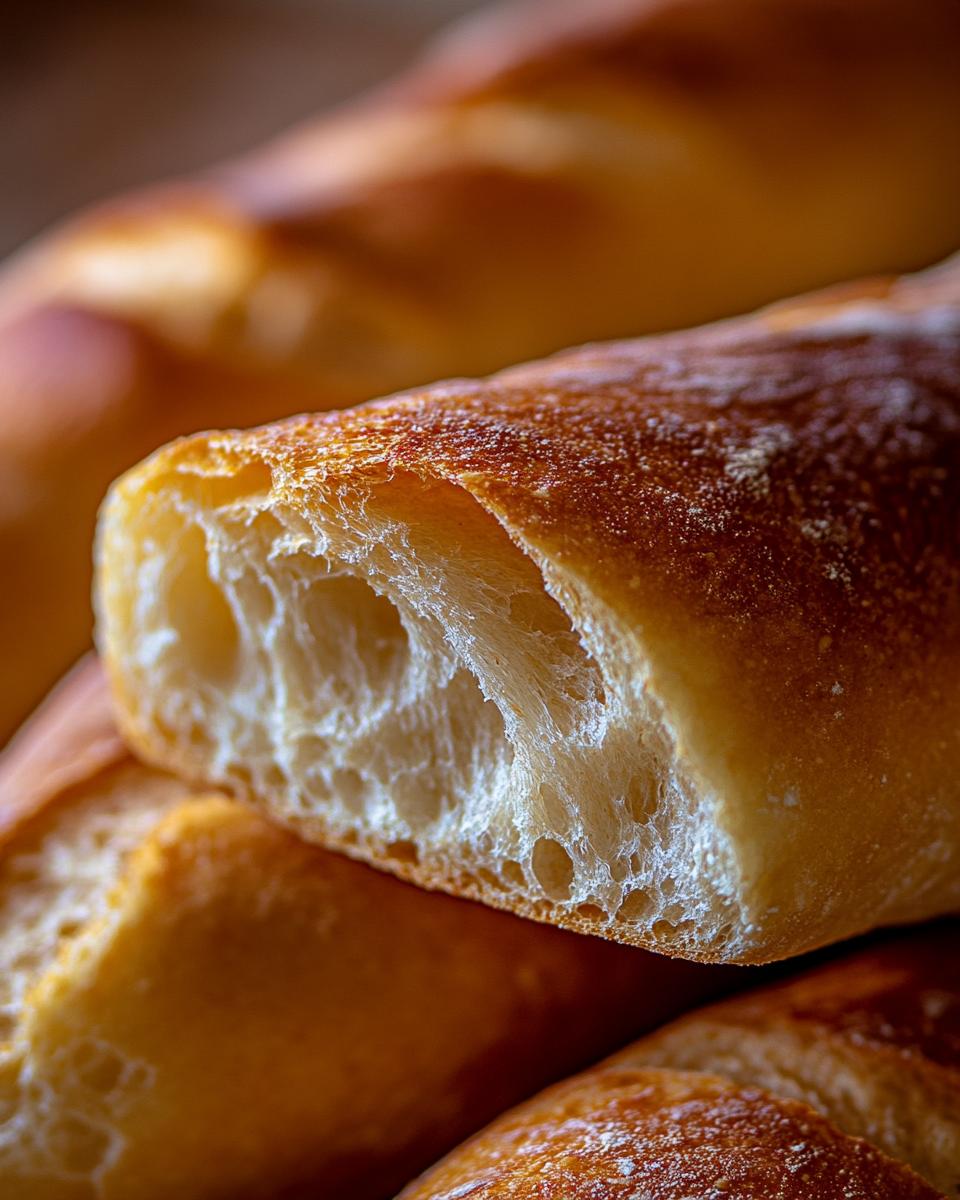Easy Baguette Recipe: Master French Baking at Home
Craving the delicious taste of a freshly baked baguette? This easy baguette recipe is your ticket to mastering French baking in your own kitchen. Whether you’re a beginner or a seasoned baker, this guide will lead you through each step with ease.
In this recipe:
- Simple ingredients list
- Step-by-step instructions
- Pro tips for perfect results
- FAQs answered
Imagine the aroma of freshly baked bread filling your home. This recipe simplifies the process, so you can enjoy authentic baguettes without fuss. With just a few ingredients and some patience, you’ll be able to bake like a pro.
Already mastering desserts? Check out our Macaron Recipe Easy for another French delight. Or, for more bread baking tips, our Kitchenaid Bread Recipe will help you perfect your homemade loaves.

Who Can Make This Recipe and What You Need
This easy baguette recipe is perfect for anyone, whether you’re a complete novice or an experienced home baker. If you’re looking for a simple baguette recipe that doesn’t require a lot of fuss, you’ve found it. The difficulty level is easy, making it ideal for beginners who want to learn how to bake baguette at home.
Basic Kitchen Equipment
To get started, you’ll need some basic kitchen equipment:
- A large mixing bowl
- Measuring cups and spoons
- A baking sheet
- Parchment paper
- A kitchen thermometer
These tools are essential for achieving the best results. The kitchen thermometer ensures your water is at the perfect temperature, crucial for activating the yeast properly. If you don’t have one, consider investing in a reliable kitchen thermometer.
The ingredients are straightforward and easy to find. You probably already have most of them in your pantry. The beauty of this homemade baguette bread recipe is its simplicity. No need for special equipment or ingredients; just follow the steps, and you’ll have delicious, crusty baguettes in no time.
Ready to experience the magic of baking your own baguettes? With this easy homemade baguette recipe, you can bring the taste of France into your kitchen.
Ingredients Needed to Make Easy Baguette
Now that we’ve discussed the minimal equipment required, let’s dive into the specific ingredients needed to make this easy baguette. Choosing the right ingredients is essential to achieving the perfect texture and flavor of a traditional baguette. Luckily, this recipe only calls for a few simple ingredients that you probably already have in your kitchen.
Simple and Accessible Ingredients
Here’s what you’ll need:
- 2 cups (250g) bread flour
- 1 teaspoon (5g) active dry yeast
- 1 teaspoon (5g) salt
- 1/2 cup (120ml) warm water (around 100°F/38°C)
- 1/2 cup (120ml) cold water
- 1 tablespoon (15g) unsalted butter, softened
- 1 egg, beaten
- 1 tablespoon (15g) sugar
- 1/2 teaspoon (2g) instant yeast
- 1/4 teaspoon (1g) salt
Most of these ingredients are pantry staples, making this recipe convenient and accessible. For precision, it’s important to measure the quantities accurately. If you don’t have bread flour, you can substitute with all-purpose flour, but note that the texture might be slightly different.
Don’t have active dry yeast? You can use instant yeast instead, but be mindful that the rising time may be shorter. The key to easy baguette dough prep is ensuring you have fresh ingredients, especially the yeast, to help your dough rise properly.
Ready to gather your baguette ingredients and procedure? Let’s get started with the next steps to create your delicious homemade baguette. With these traditional baguette ingredients, you’ll be well on your way to baking like a pro!

Step-by-Step Guide on How to Make Easy Baguette
Now that you have gathered all the necessary ingredients, let’s move on to the exciting part – how to bake baguette at home! Follow these detailed instructions to achieve perfect results every time.
- Combine Dry Ingredients: In a large mixing bowl, whisk together 2 cups of bread flour, 1 teaspoon of active dry yeast, and 1 teaspoon of salt. This ensures even distribution of yeast and salt throughout the flour.
- Mix Wet Ingredients: In a separate bowl, mix 1/2 cup of warm water (around 100°F/38°C), 1/2 cup of cold water, and 1 tablespoon of softened unsalted butter. Stir until the butter is fully melted and combined.
- Form the Dough: Gradually add the wet ingredients to the dry ingredients while mixing. Continue to mix until a shaggy dough forms. This is the beginning of your baguette dough preparation.
- Knead the Dough: Knead the dough for about 10 minutes until it becomes smooth and elastic. You can do this by hand or with a stand mixer using a dough hook attachment.
- First Rise: Place the dough in a lightly oiled bowl and cover it with plastic wrap. Let it rise in a warm, draft-free place for 1-2 hours, or until it has doubled in size.
- Punch Down and Shape: Punch down the risen dough to release air. Follow how to shape baguette dough by rolling it into a long, thin strip and then shaping it into a baguette form. This step is crucial for the right texture.
- Second Rise: Place the shaped baguette on a baking sheet lined with parchment paper. Cover it with plastic wrap and let it rise for another 30 minutes.
Final Preparation and Baking
Preheat your oven to 425°F (220°C). While waiting, brush the baguette with a beaten egg and sprinkle with sugar. This gives your baguette a beautiful golden crust.
- Score the Dough: Using a sharp knife, make several diagonal slashes on the surface of the dough. This helps the baguette expand properly while baking.
- Bake: Place the baguette in the preheated oven and bake for 20-25 minutes, or until it is golden brown and sounds hollow when tapped.
- Cool Down: Remove the baguette from the oven and let it cool on a wire rack. Enjoy your homemade baguette fresh, or store it in an airtight container at room temperature for up to 2 days.
Follow these steps, and you’ll master this baguette recipe for beginners in no time! Happy baking!
Serving and Storing Ideas and Tips
Now that you’ve mastered the steps to make your own delicious baguette, let’s talk about the best ways to serve and store your homemade creation. This section will ensure your bread remains fresh and tasty while also exploring exciting ways to enjoy it.
Serving Your Baguette
The best way to serve baguette bread is fresh out of the oven, but there are many creative options to delight your taste buds. For a simple yet delicious treat, slice the baguette and serve it with butter, cheeses, or dips. Consider these baguette breakfast ideas: top slices with avocado and poached eggs, or slather on some Nutella for a sweet morning treat.
If you’re looking for how to serve baguette bread in a more substantial meal, try making sandwiches with your favorite fillings or use it as a base for bruschetta. Don’t forget to pair it with soups or salads for a complete meal experience.
Tip: Use a sharp bread knife to make neat, even slices, and avoid squashing the loaf.
Storing Your Baguette
To keep your baguette fresh, store it in a paper bag at room temperature for up to two days. Avoid plastic bags, as they can make the crust soggy.
If you have a day-old baguette and are wondering what to do with it, here are some easy recipes with day-old baguette. Make croutons by cutting the bread into cubes, tossing them with olive oil and herbs, and baking until crispy. Alternatively, try making French toast or bread pudding for a delightful dessert.
Tip: To refresh a stale baguette, lightly sprinkle it with water and bake at 350°F (175°C) for about 10 minutes.
By following these serving and storing tips, you will ensure that your homemade baguette remains delicious and versatile, perfect for any meal or occasion.

Pro Tip
- Always preheat your oven for an even bake.
- Use a kitchen thermometer to check water temperature.
- For a crispy crust, place a pan of water in the oven.
- Don’t skip scoring the dough; it helps the baguette rise evenly.
- Let the dough rise in a warm, draft-free area.
- Brush the baguette with water before baking for extra crunch.
- Allow the baguette to cool on a wire rack.
FAQ
1. Can I use all-purpose flour instead of bread flour?
Answer: Yes, you can use all-purpose flour in place of bread flour. However, keep in mind that bread flour has a higher protein content, which helps develop gluten and gives the baguette its characteristic chewy texture. Using all-purpose flour may result in a slightly less chewy baguette. For ingredient replacement options, consider adding a tablespoon of vital wheat gluten to each cup of all-purpose flour to mimic bread flour’s properties.
2. What are some money-saving options for ingredient substitutes?
Answer: To save money while baking baguettes, you can make a few substitutions. For instance, instead of using unsalted butter, you can use margarine or even a small amount of vegetable oil. If you don’t have bread flour, as mentioned earlier, all-purpose flour with added gluten works well. Additionally, instant yeast can be used instead of active dry yeast, which might be available in bulk at a lower cost. These money-saving options help you bake delicious baguettes without breaking the bank.
3. What are some relevant tips to ensure my dough rises properly?
Answer: Ensuring your dough rises properly is crucial for a successful baguette. First, make sure the water you use to activate the yeast is at the right temperature, around 100°F (38°C). Too hot or too cold water can kill the yeast or inhibit its activity. Secondly, place your dough in a warm, draft-free environment to rise. Covering the bowl with a damp cloth can also help maintain humidity. Lastly, if your home is particularly cold, you can place the dough in an oven with the light on to create a warm environment. These relevant tips ensure that your dough rises perfectly every time.
4. How do I get a crispy crust on my baguette?
Answer: To achieve that iconic crispy crust, you can use a few baguette baking tips. One effective method is to place a pan of water on the bottom rack of your oven while baking. The steam from the water helps to create a crisp and golden crust. Additionally, you can spray the baguette with water before baking and again halfway through the baking process. Scoring the dough with a sharp knife also allows it to expand properly and develop a beautiful crust.
5. Can I make baguettes without a stand mixer?
Answer: Yes, you can absolutely make baguettes without a stand mixer. While a mixer makes the kneading process easier, you can knead the dough by hand effectively. It might take a bit more time and effort, but the results are just as delicious. Hand-kneading allows you to feel the dough’s texture and elasticity, ensuring it reaches the perfect consistency. For more detailed instructions, you can check out this helpful guide on baking baguettes for beginners.












